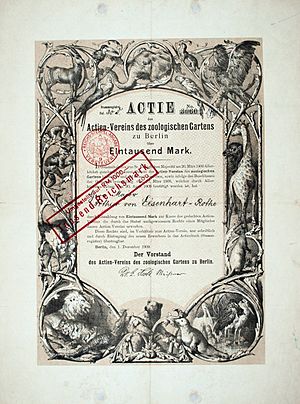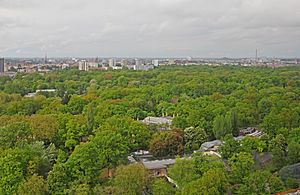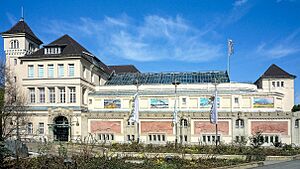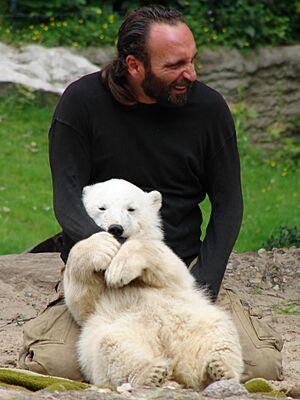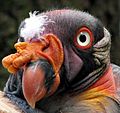Berlin Zoo facts for kids
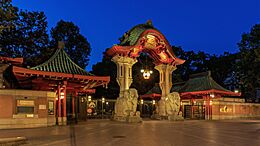
The Elephant Gate: one of two zoo entrances
|
|
| Date opened | 1844 |
|---|---|
| Location | Berlin, Germany |
| Land area | 35 hectares (86.5 acres) |
| Coordinates | 52°30′30″N 13°20′15″E / 52.50833°N 13.33750°E |
| No. of animals | 20,219 (December 2017) |
| No. of species | 1,373 (December 2017) |
| Annual visitors | More than 3.5 million (2017) |
| Memberships | EAZA, WAZA |
The Berlin Zoological Garden, also known as the Berlin Zoo, is the oldest and most famous zoo in Germany. It opened its doors in 1844. The zoo covers about 35 hectares (86 acres) and is located in Berlin's Tiergarten area. It is home to around 1,380 different species and over 20,200 animals. This makes it one of the largest and most diverse animal collections in the world.
In 2017, the zoo and its aquarium welcomed over 3.5 million visitors. This makes it the most-visited zoo in Europe and one of the most popular worldwide. Many people love to watch the regular animal feedings. Famous animals like Knut the polar bear and Bao Bao the giant panda have made the zoo very well-known.
The Berlin Zoo works with many universities, research centers, and other zoos globally. It helps with special breeding programs in Europe to protect endangered species. The zoo also takes part in projects that help bring animals back into their natural homes.
Contents
Discover the Zoo's History
The Berlin Zoo first opened on August 1, 1844. It was the second zoo ever in Germany. The first animals were a gift from Frederick William IV, who was the King of Prussia. These animals came from his own animal collections. The zoo's aquarium opened later, in 1913. A nearby train station, Berlin Zoologischer Garten, was built in 1882.
The Zoo During World War II
During World War II, the zoo was hit by bombs starting in 1941. The worst damage happened in November 1943. Many animals were killed, and the aquarium building was completely destroyed. For example, only one of eight elephants survived. A young hippo named Knautschke was also saved.
Heavy fighting continued in the zoo area in April 1945. Zoo keepers had to make difficult choices to protect people and other animals. A large anti-aircraft tower, called the Zoo flak tower, stood next to the zoo. It was one of the last places where German forces fought. On May 31, 1945, only 91 out of 3,715 animals had survived. This included two lion cubs, a chimpanzee, and the elephant Siam.
After the war, the zoo and aquarium were rebuilt. They were designed to show animals in ways that felt more like their natural homes. This new approach helped the zoo become very successful at breeding animals, even rare ones.
The Zoo After the War
The Berlin Zoo was located in what became West Berlin. Because of this, another zoo, Tierpark Berlin, was built in East Berlin.
Exploring the Berlin Zoo
The Berlin Zoo is the most visited zoo in Europe. It welcomes over 3.3 million visitors each year from all over the world. The zoo is open every day of the year. It is easy to reach by public transport. The Berlin Zoologischer Garten railway station is a major transport hub. You can find U-Bahn, S-Bahn, and bus connections there.
Visitors can enter the zoo through two main gates. One is the beautiful Elephant Gate, next to the aquarium on Budapester Straße. The other is the Lion Gate on Hardenbergplatz. The original Elephant Gate was built in 1899 but was destroyed in World War II. It was rebuilt exactly as it was in 1984.
The zoo has always had a large and varied collection of animals. Before World War II, it had 4,000 birds and mammals from 1,400 species. The aquarium held 8,300 reptiles, amphibians, and invertebrates from 750 species. Today, the collection is similar in size. The zoo now focuses on creating natural-looking homes for its animals.
The Berlin Zoo helps protect many endangered species. It keeps special records for black and Indian rhinoceroses. It also helps with breeding projects for rare deer and pigs. The zoo supports conservation efforts in other countries, like Madagascar. It is also a partner of the Stiftung Artenschutz, a foundation that protects species.
The zoo is home to four types of great ape: orangutans, gorillas, chimpanzees, and bonobos. The carnivore house displays all the big cats. It also has many rare small predators, like ring-tailed mongooses from Madagascar. In the basement, you can explore the world of animals that are active at night.
The bird house features a large walk-through aviary. It has many different kinds of birds, including hornbills and parrots. There are also big aviaries for wading birds and herons. The Berlin Zoo is one of the few zoos that has tuatara (in the aquarium) and Luzon tarictic hornbills.
The Aquarium
The aquarium was built in 1913. It is part of the Berlin Zoo complex. Besides fish and other water animals, it is home to most of the zoo's reptiles, amphibians, and invertebrates.
Famous Animals of the Zoo
Knut the Polar Bear
Knut was a polar bear born at the zoo on December 5, 2006. His mother did not care for him and his twin. So, zookeeper Thomas Dörflein raised Knut. Knut became very famous around the world. He appeared on TV, in books, and on many products. He helped the zoo earn a lot of money in 2007. Zoo visits increased by about 30% that year. Knut passed away on March 19, 2011.
Bao Bao the Giant Panda

Bao Bao (1978–2012) was one of the first two giant pandas in Germany. He was given to West Germany by China in 1980. For a time, he was the oldest known panda living in a zoo. He lived with another panda named Tjen Tjen, who passed away in 1984. Bao Bao was loaned to London Zoo for a few years. Later, another female panda named Yan Yan came to Berlin from China to try and have cubs with Bao Bao. They did not have any cubs, and Yan Yan passed away in 2007.
In the summer of 2017, new giant pandas came to Berlin Zoo. Jiao Quing and Meng Meng arrived from China for a breeding program. In September 2019, Meng Meng gave birth to twin male panda cubs, Pit and Paule. Then, on August 22, 2024, Meng Meng had another set of twin panda cubs, this time two females.
Fatou the Gorilla
Fatou the female gorilla was born on April 13, 1957. She came to the zoo when she was about two years old. In 1974, she gave birth to Dufte, the first gorilla raised at the Berlin Zoo. As of August 2025, Fatou is one of the oldest living gorillas in zoos worldwide.
Incidents at the Zoo
In 2009, a woman was injured by polar bears after she entered their exhibit. She was taken to the hospital and recovered.
See also
 In Spanish: Jardín zoológico de Berlín para niños
In Spanish: Jardín zoológico de Berlín para niños
- List of zoos in Germany
- List of tourist attractions in Berlin
Images for kids
-
Southern ostrich


